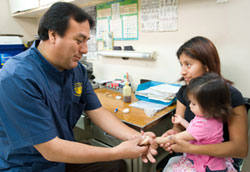HIV/AIDS: 30 years of hard-won victories
July / August 2011 | Volume 10, Issue 4

Photo by David Snyder
Significant advances have been made in
addressing mother-to-child-transmission
of the HIV/AIDS virus.
While extraordinary scientific, medical and public health accomplishments have been made in the battle against HIV/AIDS, major challenges remain, especially in the delivery of therapies and prevention tools to the resource-poor countries that need them the most. The National Institute of Allergy and Infectious Diseases (NIAID) played an important role in the design and early implementation of the President's Emergency Plan for AIDS Relief (PEPFAR) and continues to serve as a scientific partner for that program. NIAID has led much of the research that supports the program, engaging scientists from throughout the world and many U.S. biomedical and public health research institutions.
NIAID's investment in HIV/AIDS research has generated many significant findings in preventing, treating and advancing scientific understanding of the disease. Most recently, an NIAID-funded clinical trial demonstrated that early initiation of antiretroviral therapy by the infected partner in heterosexual couples where one partner was HIV-infected and the other was not reduced the risk of HIV transmission to the uninfected partner by 96 percent. In 2010, a study cosponsored by NIAID and the Bill & Melinda Gates Foundation and conducted at 11 global sites found that a daily dose of an oral antiretroviral drug approved to treat HIV infection reduced the risk of HIV acquisition among men who have sex with men by 44 percent. The study, known as iPrEx, found even higher rates of effectiveness, up to 73 percent, among study participants who adhered most closely to the daily drug regimen.
These landmark findings followed closely on the heels of another breakthrough international study, CAPRISA 004, which found that heterosexual women who used a vaginal microbicide gel containing a one percent concentration of the antiretroviral drug tenofovir had 39 percent fewer HIV infections than those study participants who used a placebo gel. NIAID was among the organizations that provided substantial support and resources to establish the infrastructure and training for the Centre for the AIDS Programme of Research in South Africa, which conducted the study. Ongoing and future clinical trials will build on these study results with the goal of developing a safe and effective microbicide.
Conducting HIV/AIDS research in international settings allows NIAID-supported scientists to study the disease under a variety of environmental and social conditions. For example, the NIAID-funded HIV Prevention Trials Network (HPTN) comprises more than 60 clinical sites in the United States, Africa, Asia, and South America. HPTN evaluates the effectiveness of various HIV prevention strategies in different populations to better understand and ultimately control the spread of HIV on a global scale.
In another recent development, scientists at NIAID's Vaccine Research Center discovered anti-HIV antibodies that have been used to identify regions of the virus vulnerable to antibody-based neutralization across a wide array of HIV strains. Based on the structure of these regions, researchers are designing proteins to elicit such broadly neutralizing HIV antibodies through immunization. Scientists envision that immunization for HIV will involve coaxing the body to develop a series of antibodies that evolve from a primitive state into a mature form through a process known as affinity maturation. By determining the genetic origin of an antibody, scientists can analyze all related genetic sequences, identify the genetic precursors of the mature antibody, and develop an immunization strategy that mimics the natural antibody affinity maturation process.
This article was adapted from NIAID Global Research: Improving Health in a Changing World [PDF 7M, 24 pages] and from the NIAID February 28, 2011 News Release 18th Conference on Retroviruses and Opportunistic Infections, Day Two: Selected Highlights of NIH-supported Research HIV/TB Co-Infection, Microbicide Developments among Key Topics Presented.
To view Adobe PDF files,
download current, free accessible plug-ins from Adobe's website.